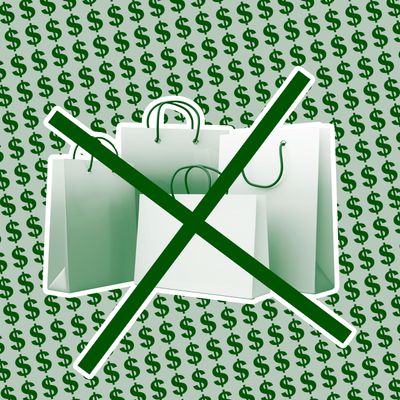
Every January, the internet is awash with no-buy challenges and budget makeovers. For most people, these strict rules are short-term (which is fine; no judgment!). But for others, they’ve become a lifestyle. Here, we spoke to three women who have done long-term shopping bans, cutting out specific categories (clothes, makeup) or even broader purchases for a year or more. Motivated by money, the environment, and the sheer quantity of stuff they already had, they’ve all found a way to stick to their resolutions. Here’s how they did it.
Angela, 32, a baker in Atlanta
Length of shopping ban: 1.5 years and counting
In September of 2022, I was living in a luxury-style apartment by myself, paying $2,000 a month in rent, and I had over $30,000 in debt. I had lived there for six months when all of my stuff started to get mold on it. So I moved out for a week while they dealt with the mold issue. During that week, I stayed in a friend’s tiny house. That’s when I realized that I couldn’t do what I was doing anymore. I couldn’t spend that much on rent and have so much debt — it was a mix of credit-card debt, car loans, and just trying-to-survive debt. I decided that I had to take control of my finances. I knew I would never be able to have the life I want if I didn’t get serious about it.
I took the next six months to figure out a cheaper living situation, which wasn’t easy because I have pets. Then I put all my stuff in storage, moved into a bedroom in a shared apartment for $700 a month, and hunkered down. For the first year, I only paid for my absolute needs — my bills, my dog’s flea and tick medication, medication for myself, food. And I cut out everything else. I got a $2 notebook from Walmart and I still use it to keep track of my bills, my paydays, and my total debt. I also keep a page where I write down everything I spend. Whenever I have a receipt, I write it in there. I named the notebook Debra. Debra is my best friend. She truly has changed my life.
Writing down my rules was also really helpful for holding myself accountable. I couldn’t buy any skin care or hair products until I was completely out of them. No new makeup at all. No new clothes unless I need them for work. No new books; I can go to the library. No home décor, no plants, no art supplies, and no nail appointments. I used to love getting my nails done, but it was a major expense that I did not need. For small treats, I get cash tips at work every two weeks — $15 to $20 — so I can use that for whatever I want. If I want to get a coffee, I can use my cash tips for that. I can buy candles, oils, or incense, but only if I finish what I already have, and only one at a time. I can buy dog toys, but I have to throw away two for every new one that I buy. And I can get takeout once a week. I don’t ever do that, but I allow myself the option for it.
I paid off all my debt a month ago. The total was $30,895.05, and I paid it off in 488 days. That’s $63 a day. I make about $45,000 a year, so I’m really proud of that. But I also know that not everyone can do this. I don’t have any children or family to take care of. My only family is my brother, and he’s been really supportive.
I’ve whittled things down to five or six bills. I pay for rent, insurance, my phone bill, my storage unit, and Hulu. A lot of people tell me to get rid of the storage unit, and I just cannot do that. I love all my stuff that’s in there — these really nice Crate & Barrel stools, and a Pottery Barn couch that was given to me secondhand. If anything, keeping the storage unit helps prevent me from buying things, because I know I already have it and we’ll be reunited when I become a homeowner, which is my next goal. My hope is to be in my own place within two years. I’m keeping my eyes on the prize.
Now that I’m out of debt, I’m trying to loosen my rules a little bit and not be quite so restrictive. But I’ve been very thoughtful about it. For example, I want a hair-care routine. I just bought some new hair products. Afterwards, I was like, Whew. That was a lot. I have to remind myself that it’s okay to spend money sometimes now. I’m never going to be back where I was ever again.
Angela Rozmyn, 36, works in affordable green housing in Washington and is the co-founder of Women’s Personal Finance, a financial support network
Length of clothes-buying ban: 7 years and counting
In March of 2017, I decided I wouldn’t buy any new clothes for a year. I wanted to create a capsule wardrobe, but I had so much stuff that it didn’t feel right to just trash my whole closet and start over. So I figured I’d wear through all my clothing and then, after a year, buy some new stuff guilt-free. Then, after a few months, I realized that not thinking about clothing or buying new clothes cleared up a lot of brain space for me. So I decided to keep going.
Before I started the ban, I think I had pretty typical shopping habits for a millennial woman — I was spending in the range of about $1,000 a year on clothes. This was especially true after I had my son, because when you have a small child, you get very, very little time to yourself. Once a week before I picked him up from day care, I would go to Ross or TJ Maxx just to walk around for an hour and be on my own. And, of course, when you do that, you inevitably buy things. So I had to rethink how I’d find time for myself. Why don’t I go for a walk in the woods? Why don’t I go for a long run? Why don’t I sit down and read that book? There are a lot of other activities that I enjoy more than shopping, but they took a little bit more intentionality.
It took about three to six months before I stopped wanting to shop. Everybody says that if you do something for 30 days, it becomes a habit. And I don’t know if that’s bad advice across the board, but I found that it took me much longer. It’s almost like a phantom-limb syndrome, where certain behaviors are ingrained. But I think 30 days gave me glimmers of how life-changing it could be long-term.
When people hear that I haven’t bought clothes in seven years, they think, “Oh, but my clothes don’t last that long.” And some of mine have, but some of them haven’t. I’m open to accepting hand-me-downs, and I have organized clothing swaps and will accept things from “buy nothing” groups. I’ve found that when you’re open to getting things from other people, it’s easier than you might think.
It also helps that I’m really strict about one area of my life, but not elsewhere. I’ve done stricter no-spend months before, and they have been somewhat successful in the short term, but in the long term, they don’t actually stick. Just focusing on cutting out clothes is much more sustainable for me. Sometimes it feels weirdly indulgent — by cutting out something that’s a big part of a lot of people’s lives, I get more freedom to spend on other things.
It also helped that I’m very online, and I made it public. It gave me some accountability. For instance, I took a trip and it rained a bunch, and the rain jacket I brought wasn’t great. It would have been easy to cave and get a new jacket, but I wanted to stay accountable. In the end, it wasn’t that big a deal. It’s not like I have this terribly hard life. I can be a little bit uncomfortable for a few days.
A funny side effect is that I’ve also completely stopped buying makeup since the clothes-buying ban started. That was never my goal. But as I pulled back from all of the fashion-influencer stuff, I naturally lost interest. A few months in, I put on makeup to get ready for an event, and I was like, “I don’t like this.” So I don’t use makeup anymore.
I do get a lot of hand-me-downs, especially now that so many people know that I don’t buy clothes. But it was a little awkward at first, especially for stuff like underwear and socks. We’re not socialized to accept free stuff. We don’t want to look like we’re needy or opportunistic. Part of what helped me get over that, though, is that I cloth-diapered my son. People use hand-me-down cloth diapers and nobody blinks an eye. There is not one little bit of weirdness. And diapers get pooped in! If we can clean used diapers, we can clean used underwear and it’s perfectly acceptable. Not to mention, a lot of new clothes are not especially clean when they come from a store — anyone who works in retail will tell you that. So I’ve accepted pre-owned underwear and socks from various people, and I wash them, and it’s fine.
Cassandra, 35, works in marketing in Oregon
Length of clothing ban: 2 years and counting
I started working from home during the pandemic, and I remember reading an article about how most people only wear each piece of clothing two times before they toss it. I don’t know if that’s actually true, but it made me think — I don’t even go into an office anymore, so what am I doing with all this clothing sitting in my closet? I decided not to buy any more clothing, and to try to wear everything I owned more, because it’s perfectly fine and fits me and is appropriate for work. That was about two years ago, and it’s still going strong.
Then I also banned buying yarn. My major hobby is knitting and crocheting, and buying yarn had become part of the hobby, too. So I forced myself to just work with what I’ve got, and it’s ended up in some really creative pieces. And I’m actually putting a dent in my yarn stash.
My main motivations were financial and also wanting to use what I have. I’m not a billionaire who’s using a jet to go to my private island constantly, but this is something little that I can do and have some influence on my footprint.
In terms of how much money I’ve saved, I used to spend probably about $50 on new clothing each month. When it was sweater season, I’d get a new cardigan or whatever. As for yarn, oh, man. I’m pretty into the yarn community, and once you get into the indie yarn, it’s like $25–$30 a skein. So buying enough for a big project, like a sweater or a blanket, is up there in hundreds of dollars. I had so much yarn that I couldn’t even remember what I’d bought. And it was the same with clothes — I’d look through my closet and be like, “Oh, I forgot I had that. That looks great.” On average, I was probably spending about $50 a month on yarn too. So, when you add that up, I’ve saved a significant amount of money over the last two years — a few thousand dollars, at least. I make about $50,000 annually, so I’ve put that extra money toward our house payments.
Not shopping was really hard at first because it was such a routine. I removed the Amazon and Walmart apps from my phone. Then I removed my credit card information from my browser on my computer. So if I want something, I have to get up and go get my credit card and put in the number manually, and then put my card back so it doesn’t sit by the computer.
At first, it did feel like deprivation. Sometimes, when I had a hard day at work, I really just wanted to scroll Amazon and see what’s recommended for me and just mindlessly entertain myself by shopping. And not doing that made me a little sad. I was like, “Oh, everybody’s buying cool new stuff, but I’m not.” Then, after about a month or two, it felt more automatic and stopped mattering so much to me. I was like, “Oh, that thing I want — it’s just marketing. This feeling will pass, and I’ll still be here.”
Fashion is so volatile, and trends change so fast, but I’ve found that I can approximate most outfits using a mix of what I already have. I’ll go on Pinterest and see what people are wearing, and then I’ll look at my closet and be like, Yeah, I’ve got some of these things. Let’s see if I can make it work. Of course, I could just wear a black collared shirt and pants and put my hair in a bun until I die, but I do like to mix things around. Getting dressed is still fun for me.
Some of my clothes have gotten pretty worn, but I haven’t had to throw anything away. Instead, I like to repair them. My sister got into visible mending, and she’ll use bright colors and embroidery to fix things up. Admittedly, it makes clothes look a little less professional, but I can still wear them.
At this point, I don’t see myself ending the ban unless I get a new job that requires me to go into an office. Then I would probably consider buying a couple new things. My tastes have changed a lot. Now I favor pieces that are more neutral and can be easily accessorized, so I can incorporate them into my wardrobe more easily.
It also helped that when I started, I told myself that if I really hate it, I can stop. Nobody’s making me do it. It’s like anything else that you do for yourself, whether it’s changing your diet to be healthier or getting more exercise or trying to be more sociable. If it’s terrible, you can stop. So whenever people are like, “Oh, I could never do that,” I’m like, try it for a week. Maybe you’ll like it enough to keep going. And if you hate it, then at least you know it’s not your thing.
Email your money conundrums to [email protected] (and read our submission terms here.)





